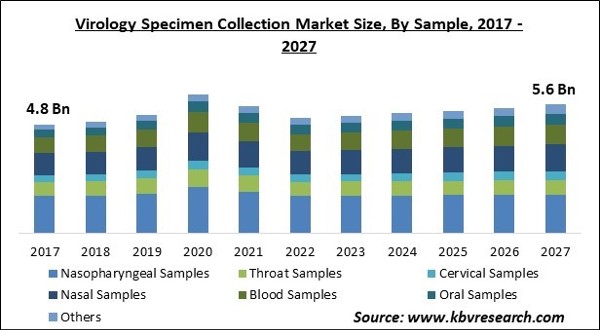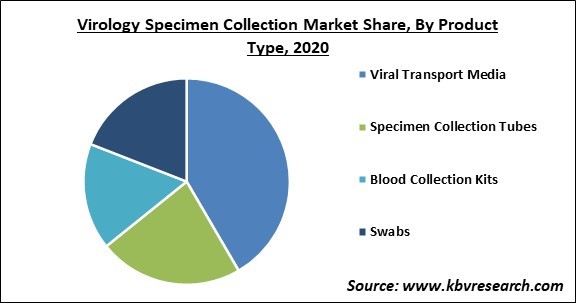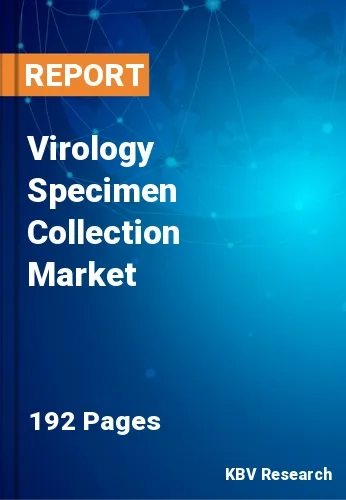The Global Virology Specimen Collection Market size is expected to reach $5.6 billion by 2027, rising at a market growth of 0.2% CAGR during the forecast period.
Virology is the study of viruses, virus-like entities, and their mutations, covering taxonomy, disease-causing qualities, cultivation, and genetics. Microbiology and pathology are commonly confused with virology. Viruses quickly evolved into tools for analysing basic biochemical processes in cells in the early years of virology, which were based on advancements in the chemical and physical sciences. Viruses have traditionally been considered as disease-causing agents that must be eradicated or controlled.
After the initial operational definition of a virus as a filterable agent, researchers attempted to find the characteristics of viruses that distinguished them from other microbes. To this aim, all viruses have the same defining feature that they are obligatory intracellular molecular parasites. The fact that viruses do not reproduce by binary fission, which is an asexual reproduction mode in which pre-existing cells split into two identical daughter cells, is a second crucial attribute of viruses.
In February 2020, for example, Becton, Dickinson partnered with Babson Diagnostics to develop small-volume blood collection systems for retail pharmacies. They partnered to make blood testing more accessible and convenient by integrating BD's blood collection device with Babson's automated sample handling and analysis capabilities.
Molecular diagnostic firms are encouraged to create bacterial and viral specimen collection as well as diagnostic solutions that have a beneficial impact on market growth attributed to the increased funding from public and private organizations. For example, the US Department of Defense and the US Department of Health and Human Services (HHS) awarded Hologic Inc. with USD 7.6 million in July 2020 to enhance the manufacturing of specimen collecting and processing consumables for SARS-CoV-2 testing.

The outbreak of the COVID-19 pandemic has impacted how medical treatment is delivered around the world. As a result of the increased demand brought on by the rising prevalence of COVID-19 hospitalizations, several hospitals and departments have redefined their strategies to handle COVID-19 patients. Curfews and lockdowns were imposed around the world as a result of the COVID-19 pandemic, halting blood donations, reducing/canceling collecting drives, and reducing demand for donated blood.
Moreover, the increased frequency of viral infections such as SARS-CoV-2, AIDS, flu, EBOLA, Zika virus, and STDs is fuelling demand for efficient virology specimen collection. According to the World Health Organization (WHO) (July 2021), at the end of 2020, there were an estimated 37.7 million (30.2–45.1 million) persons living with HIV, with almost two-thirds of them (25.4 million) living in the African Region. In 2020, 680,000 (480 000–1.0 million) individuals will have died from HIV-related causes, while 1.5 million (1.0–2.0 million) will have contracted the virus.
The outbreak of Zika and Babesia became a very critical issue for humanity. Zika virus is deadly enough to cause severe harm to people and can also cause death in some cases. On the other hand, the Babesia virus is commonly found in dogs. However, certain species of the Babesia virus can enter the human body. Identifying these viruses is a crucial matter. In addition, the fact that these viruses along with their mutations would be included in virology specimen collection tests, highlight the need for new virology specimen collection technologies, consumables, and instruments.
Virology specimen collection is an expensive measure of sample collection. However, due to their rising disposable budgets and growing healthcare infrastructure, emerging countries present potential opportunities for virology specimen collection companies. Due to rising income levels, increased health awareness, and the increasing incidence of lifestyle disorders, people are highly demanding virology tests. In India, ELISA is currently commonly utilized, whereas NAT has a limited penetration rate.
New technologies are widely employed in high-income countries and will be effectively adopted in middle and lower-income countries in the coming years, owing to an increase in blood donations, blood safety awareness, and healthcare expenditures around the world. Many developing countries, such as India and China, rely on ELISA at the moment. This is a significant impediment to NAT's current growth in the virology specimen gathering business. Due to the expensive nature of sophisticated testing, less efficient tests such as first-generation ELISA are being used more frequently. Despite its flaws, this test is widely utilized around the world.

Based on the Sample, the Virology specimen collection market is segregated into Blood Samples, Nasopharyngeal Samples, Throat Samples, Nasal Samples, Cervical Samples, Oral Samples, and Other. Samples. In 2020, the Nasal sample segment followed the Nasopharyngeal Samples by attaining the second largest revenue share of the virology specimen collection market. The increased growth of this segment is attributed to the rising prevalence of contagious viral infection across the world such as the upsurge of the Omicron virus. Due to the rising number of patients infected with this mutant of the novel coronavirus, the demand for nasal sample tests increased.
Based on Product Type, the Virology specimen collection market is segmented into Blood Collection Kits, Specimen Collection Tubes, Viral Transport Media, and Swabs. In 2020, the viral transport media segment dominated the virology specimen collection market by accounting for the largest revenue share of the market. The increased growth of this segment is owing to the rising awareness of people for donating blood. Due to the significant number of people that are donating blood, the need for virology transport is increasing.
| Report Attribute | Details |
|---|---|
| Market size value in 2020 | USD 6.1 Billion |
| Market size forecast in 2027 | USD 5.6 Billion |
| Base Year | 2020 |
| Historical Period | 2017 to 2019 |
| Forecast Period | 2021 to 2027 |
| Revenue Growth Rate | CAGR of 0.2% from 2021 to 2027 |
| Number of Pages | 192 |
| Number of Tables | 310 |
| Report coverage | Market Trends, Revenue Estimation and Forecast, Segmentation Analysis, Regional and Country Breakdown, Companies Strategic Developments, Company Profiling |
| Segments covered | Sample, Product Type, Region |
| Country scope | US, Canada, Mexico, Germany, UK, France, Russia, Spain, Italy, China, Japan, India, South Korea, Singapore, Malaysia, Brazil, Argentina, UAE, Saudi Arabia, South Africa, Nigeria |
| Growth Drivers |
|
| Restraints |
|
Based on the region, the Virology specimen collection market is analyzed across North America, Europe, APAC, and LAMEA. In 2020, North America led the world by acquiring the largest revenue share of the virology specimen collection market. The largest revenue share of the region in the market is attributed to the robust healthcare infrastructure of the region. Clinics, hospitals, and other healthcare institutes in countries across North America are equipped with the latest and cutting-edge healthcare technologies.
Free Valuable Insights: Global Virology Specimen Collection Market size to reach USD 5.6 Billion by 2027
The market research report covers the analysis of key stake holders of the market. Key companies profiled in the report include Trinity Biotech Plc, Thermo Fisher Scientific, Inc., Becton, Dickinson and Company, DiaSorin S.p.A., Vircell S.L., Quidel Corporation, Titan Biotech Ltd., Puritan Medical Products, Copan Italia s.p.a., and Hardy Diagnostics.
By Sample
By Product Type
By Geography
The virology specimen collection market size is projected to reach USD 5.6 billion by 2027.
Growing potential for Virology Specimen Collection techniques are driving the market in coming years, however, increased expenditure of virology specimen collection limited the growth of the market.
Trinity Biotech Plc, Thermo Fisher Scientific, Inc., Becton, Dickinson and Company, DiaSorin S.p.A., Vircell S.L., Quidel Corporation, Titan Biotech Ltd., Puritan Medical Products, Copan Italia s.p.a., and Hardy Diagnostics.
The Nasopharyngeal Samples market is generating high revenue in the Global Virology Specimen Collection Market by Sample 2020, thereby, achieving a market value of $1.7 billion by 2027.
The Specimen Collection Tubes market shows highest growth rate of 1% during (2021 - 2027). The rising growth of this segment is attributed to its function of offering an accurate and precise identification of the blood sample that is being carried in the container.
The North America market acquired maximum revenue share in the Global Virology Specimen Collection Market by Region 2020, and would continue to be a dominant market till 2027.
Our team of dedicated experts can provide you with attractive expansion opportunities for your business.

